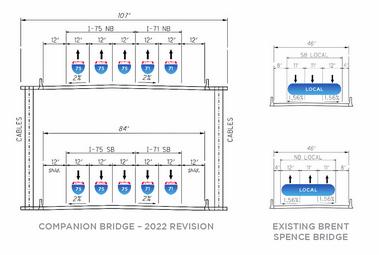The new companion bridge will provide an additional river crossing to the west of the existing structure (below).

Governors Andy Beshear and Mike DeWine said that the new plans reduce the footprint for the new bridge and propose new lane configurations to improve safety and travel between Ohio and Kentucky.
“While this is a nationally significant project, it is still very much a community-minded project,” said Beshear. “Our teams have gone to great lengths to shrink property impacts while still delivering a solid solution to the traffic congestion issues in the region.”
”It has been important from the beginning to make sure we’re meeting the needs of today and tomorrow while also being mindful about the impacts this project has on surrounding properties,” said DeWine. “I will continue to challenge our teams to look for additional ways to further these goals.”
The passage of the Bipartisan Infrastructure Law earlier this year provided a funding opportunity to move ahead on the Brent Spence Bridge Corridor project. Ohio Department of Transportation (ODOT) and Kentucky Transportation Cabinet (KYTC) began a review of former plans for a second bridge, as well as improvements to the entire 13km corridor between the Western Hills Viaduct in Ohio and Dixie Highway in Kentucky.
In 2012, the Federal Highway Administration (FHWA) had approved a plan for a new companion bridge to the west of the existing Brent Spence Bridge that will address capacity and mobility issues for interstate traffic using I-71/75 to cross the Ohio River between Ohio and Kentucky.
Initial plans included two 4.3m shoulders on each deck of the new bridge and expanded shoulder widths on the existing bridge. The new bridge was planned to cover about 10ha and span nearly 46m feet in width. Revised plans show the new bridge at almost half the size of the 2012 footprint – covering approximately 5.7ha and 25.6m in width.
 Updated plans show widened emergency shoulders on the existing Brent Spence Bridge with 3.65m shoulders provided on the new companion bridge. In addition, interstate and local traffic lanes are separated – the new companion structure will carry I-71/75 traffic; local traffic will use the existing Brent Spence Bridge.
Updated plans show widened emergency shoulders on the existing Brent Spence Bridge with 3.65m shoulders provided on the new companion bridge. In addition, interstate and local traffic lanes are separated – the new companion structure will carry I-71/75 traffic; local traffic will use the existing Brent Spence Bridge.
“We felt good about where we were a decade ago because that solution provided additional capacity that reduces congestion and improves travel throughout the corridor,” said ODOT director Jack Marchbanks. “We feel even better about this revision because it dramatically reduces the footprint of the new bridge and completely separates interstate and local traffic.” All parcels needed for the project have been acquired on the Ohio side of the project, with the exception of one commercial property, some railroad-owned land and the negotiation of two utility-owned properties.
In Kentucky, right of way activities have been divided into two sections. In both sections, the number of impacted parcels has been reduced significantly following this year’s plan revisions. In the southern portion, there are 38 impacted properties- one of which is a residential relocation; all property owners in the area have been contacted. Plans in the northern section are still being reviewed.
The project team is currently working on a second federal grant application that will be submitted by 9 August, and will continue to work with project partners on refining current plans, which call for breaking ground by the autumn of 2023.
“For decades, the Kentucky Transportation Cabinet has completed ongoing maintenance work to ensure the safety and long-term viability of the Brent Spence Bridge,” KYTC secretary Jim Gray said.
In February, Governors DeWine and Beshear signed a memorandum of understanding. The memorandum also directed transportation officials in both states to begin preparing for construction.


